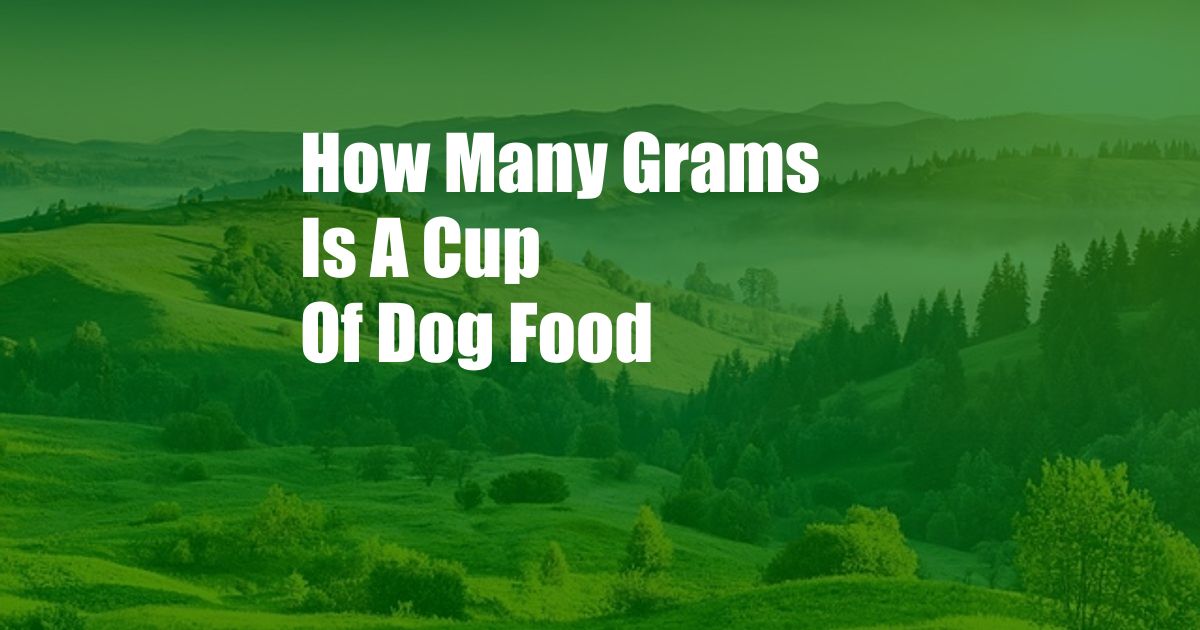
How Many Grams is a Cup of Dog Food?
As a dedicated dog owner and avid researcher, I’ve often grappled with the question of “How many grams is a cup of dog food?” This seemingly simple inquiry belies a labyrinth of factors that influence how much a cup of dog food weighs in grams.
To embark on this journey of discovery, let’s first delve into the intriguing world of dog food.
The Weighty Matter of Density
The weight of a cup of dog food is primarily determined by its density. Density, measured in grams per milliliter (g/mL), quantifies the mass of a substance per unit volume. Simply put, denser foods pack more mass into a given space, making them heavier. The density of dog food varies greatly depending on the ingredients used, the kibble size, and the manufacturing process.
For instance, a cup of dry, kibble-shaped dog food might weigh around 100 grams, while the same volume of canned dog food could weigh close to 150 grams due to its higher moisture content. The size of the kibble also plays a role; smaller kibbles tend to be denser and heavier than larger ones.
The Art of Measuring
The method of measuring dog food can also impact its weight. When using a measuring cup, the way you fill the cup can affect the amount of food dispensed. Scooping the food directly from the bag can result in a denser, heavier cup compared to gently fluffing the food before measuring it.
Furthermore, the type of measuring cup used can influence the weight. A standard 8-ounce measuring cup typically holds 100 grams of dry dog food, while a pet-specific measuring cup designed for dog food may hold slightly more or less depending on its calibration.
Expert Tips for Accurate Measurements
To ensure accuracy and consistency when measuring dog food, consider the following expert recommendations:
- Always use a standardized measuring cup specifically designed for pet food.
- Before measuring, gently fluff the dog food to remove any air pockets.
- Level off the top of the measuring cup using a straight edge or knife.
- Avoid scooping the food directly from the bag, as this can result in a denser, heavier measure.
Navigating the Food Label
Understanding the information on the dog food label can also help you determine the weight of a cup. The label typically includes a “Guaranteed Analysis” section that lists the nutritional content of the food on a dry matter basis.
For example, if the guaranteed analysis indicates that the food contains 10% moisture, then a cup of dog food that weighs 100 grams on an as-fed basis would contain approximately 90 grams of dry matter. This is because the moisture content contributes to the overall weight of the food but is not included in the nutritional calculations.
Conclusion
Determining the exact weight of a cup of dog food in grams can be a complex endeavor influenced by factors such as density, measuring techniques, and food label information. By considering the insights and tips provided in this article, you can gain a deeper understanding of this seemingly straightforward question and ensure that your furry companion receives the appropriate amount of nutrition every meal.
Are you interested in further exploring the fascinating world of dog food and its nutritional intricacies?
Frequently Asked Questions
Q: How do I convert grams of dog food to cups?
A: To convert grams to cups, divide the weight in grams by the density of the dog food. For example, if a cup of your dog food weighs 100 grams, and the density is 1.2 g/mL, then the conversion would be 100 grams / 1.2 g/mL = 83.33 cups.
Q: Is it better to measure dog food by weight or volume?
A: Measuring dog food by weight is generally more accurate and consistent, as it eliminates variations in density and measuring techniques. However, measuring by volume can be convenient, especially when using a pre-measured pet-specific measuring cup.
Q: How do I choose the right density for my dog’s food?
A: The appropriate density for your dog’s food depends on their individual needs and preferences. Denser foods may be suitable for dogs that need to gain weight or have a high energy level, while less dense foods may be better for dogs that are trying to lose weight or have sensitive stomachs.
Q: Can I use a human measuring cup to measure dog food?
A: While it is possible to use a human measuring cup to measure dog food, it is not recommended. Human measuring cups are typically designed for measuring liquids and may not provide an accurate measurement for dry dog food.
Q: How often should I change the measuring cup I use for dog food?
A: Regularly cleaning and inspecting your measuring cup is essential. Replace it if it becomes damaged or warped, as this can affect the accuracy of your measurements.